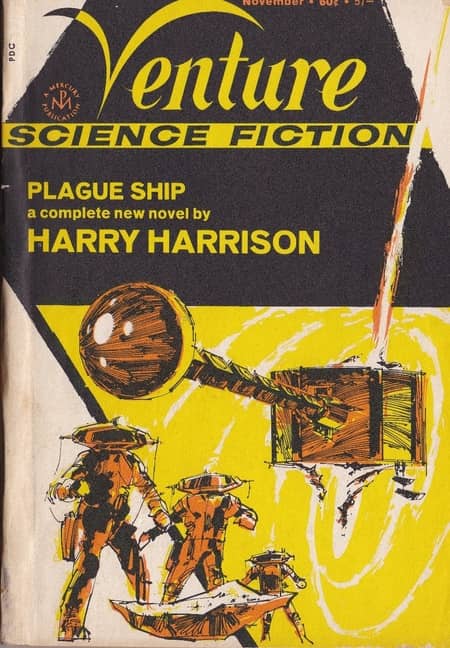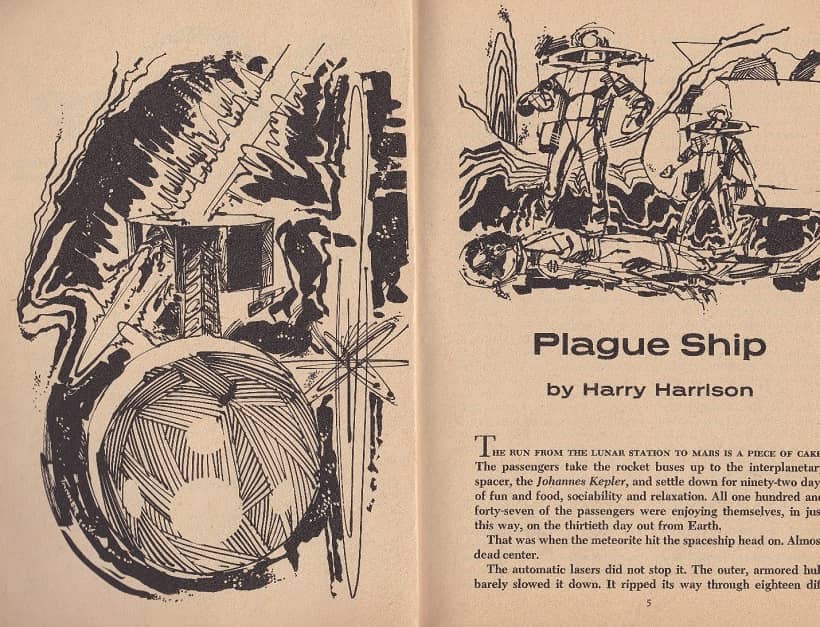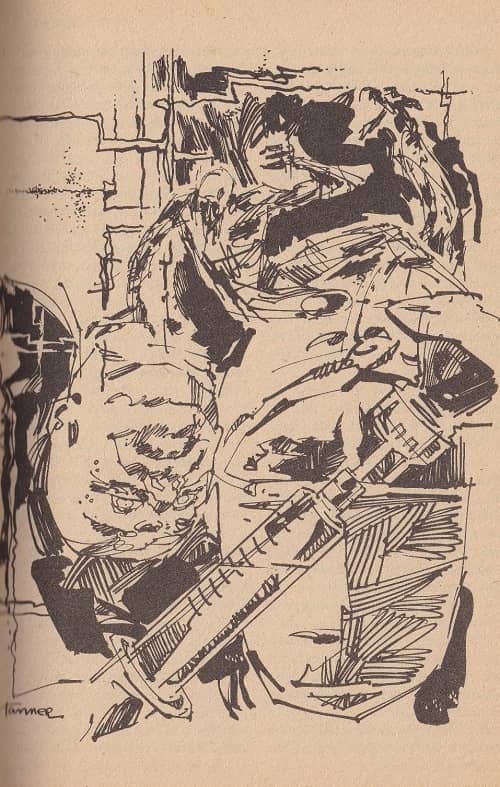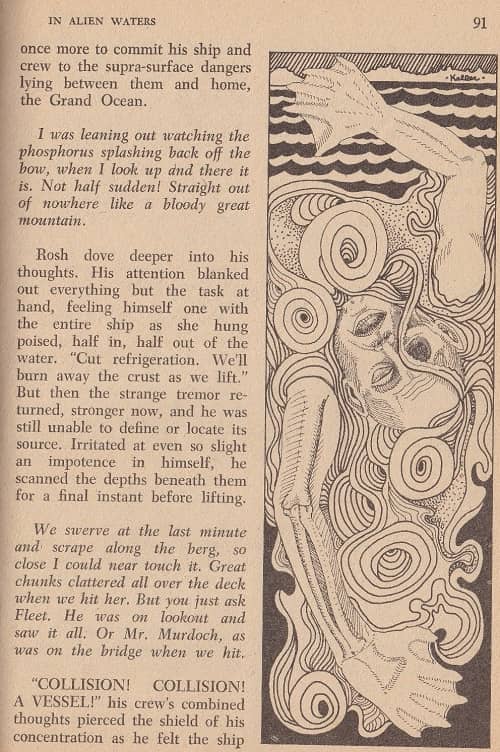Venture Science Fiction, November 1969: A Retro-Review
This is Part 6 of a Decadal Review of vintage science fiction magazines published in November 1969. The previous articles are:
Amazing Stories, November 1969
Galaxy Science Fiction, November 1969
The Magazine of Fantasy & Science Fiction, November 1969
Worlds of If, November 1969
Analog Science Fiction/Science Fact, November 1969
I approached Venture with a sense of trepidation, fearing that it was a place for cast-offs from Galaxy, there might be a diamond in the rough, maybe a good B-side. I am happy to report that I was totally wrong about that.
“Plague Ship,” by Harry Harrison, illustrations by Bert Tanner. This is an entire novel (about 82 pages, in -magazine). Normally I would summarize, but in this case, the people at Venture did it for me!
The interplanetary spacer, Johannes Kepler, was thirty days out from Earth when the meteorite hit the spaceship head on. Almost dead center. The survivors, led by a young medic, began a desperate struggle for their lives, not realizing that as bad as things were, they were soon to get worse.
That’s what is promised and rest assured that Harry Harrison delivers!
[Click the images for Venture-sized versions.]
The story starts seconds after the meteorite hits the ship and young Lieutenant Donald Chase, the ship’s new doctor out on his first voyage, jumps into action. Except that there isn’t that much action for him to deal with, as this is one of those incidents where you are either scraped up a little bit or you are dead. While Don deals with a handful of few injured, the ship and crew take care of the leak, acting on automatic and training, and only then do they realize that the meteorite holed the bridge and the entire command crew is dead. The remaining senior officer of the ship is Holtz, the chief engineer, and he is the only person who can man the engines, so he abdicates command to the second senior officer — Dr. Donald Chase.
And off we go! The Johannes Kepler (called The Big Joe) is in a bad way. Struggles are had! Junior officers are the best of what’s left. The radio is damaged, massive solar flares are comin’, how far off course are we? Not enough fuel to get back on! Oxygen levels dropping! This mutiny Mr. Briggs! Mutiny!
Problem: Massive Solar Flares
Solution!: Reorient the ship so the engine is toward the sun, move everyone into the engine room and use the shielding to protect them from both the engine radiation and the solar flare radiation.
Problem with the solution: The bridge will be exposed to the flare killing whoever is trying to navigate, and the ship (because the computer is out) will drift and everyone else will die
Solution to the problem with the solution!: Get a guy in a rad suit, put him the bridge latrine, run the controls to it, seal and flood the room with water for extra shielding.
Problem with the solution to the problem with the solution to the problem: Just how much air does this rad suit have?
Problem: Radio is damaged
Solution!: Jury rigged a fix!
Problem with the solution: Too weak to send out a signal, can barely receive signals. How is the Big Joe going to contact Mars and figure out how to get back on course?
Solution to the problem with the solution: Screw the radio and send out radar pulses in Morse code
Problem: How far off course are we?
Solution- via radar/radio pulses Mars station can do the math for us.
Problem: Not enough reaction mass to get back on course!
Solution: Everything must go! Carpet? Out the airlock! Luggage? Out the airlock! Foodstuffs? Out the airlock and everybody has to develop a taste for dried emergency rations.
Problem: Between the meteor impact and the radiation most of our algae colonies are dead. Not enough oxygen!
“How long before it reaches the danger level? [Captain Don] asked.
“Days at least, I’m not sure. But something should be done now…”
“Not at the present moment. I’ll be down to air control as soon as I can. Who is in charge?”
The crewman, he could not have been over twenty years old, looked uncomfortable. “Well, Lieutenant Hong is dead, so I guess that leaves me.”
“What’s your name?”
“Hansen, Air Tenders Mate 3rd Class Hansen.”
“All right, Hansen, you are now acting air control officer. Do your work well because all depend on you.”
Hansen’s Solution: Hydrolysis of the water into life-giving oxygen.
There is also a fire and a plague. Turns out that meteor contained alien bacteria. But as it is still lodged in the interior of the cargo bay they can get it and work with an unmutated strain for a vaccine. Which they could do, but then the mutiny starts!
Once that gets taken care of, they suit up and head into the cargo bay, which is in the middle of the ship, and thus in practically zero gravity. Desperation and brute strength are called for!
The meteorite had emerged from the container and plunged into a bale nearby, one of the many secured by a tight net of plastic strands.
“Clothing,” the chief [Kurikka] said, reading the label. “This is good luck. The layers inside will have slowed and stopped the thing, maybe even caught it. Use your knife, cut the net and we’ll pull the bale out.”
Cutting the plastic was easy enough, but extracting the bale, tightly wedged in by the others, proved impossible.
“We’ll have to cut them all free,” Kurikka said, slashing at the strands, “then shove them apart.”
The bales surged and pushed against each other as the strain was released, moving with a life of their own. Soon there were bales floating all around them, bumping into them, getting in their way. With the pressure relieved, they grabbed the one they wanted and managed to heave it free. Kurikka turned it end for end and threw his light on it.
There was an exit hole in it.
“The next one. The meteorite is still further on,” he said.
Floating bales, filled the space around them, jammed against them when they tried to move. The second layer was still wedged tightly together.
“We’ll never get these free,” Don said.
Maybe we won’t have to — look!” He flashed his light into the opening and deep down it lit up a roughened surface, “It’s inside this one!.”
With a quick slash of his knife he cut open the bale and heavy clothing drifted out. They rooted like mice in grain, hurling the clothing aside, stuffing it behind them, digging gdeeper and deeper until they came to it.
“That’s it,” Don said. He was exhausted and empty of any emotion.
It looked so commonplace. A chunk of dirty rock.
This is one of those great puzzle-box kinds of stories, and it holds together quite well. As Don is a doctor, not a real (or even very experienced) spacer, Harrison gets around the “as you know, Don” conundrum with the much better “Tell me again how this mass of twisted metal and melted plastic is supposed to work.” There is also a couple of civs who have to step in, so they get to explain and be explained to.
The mutiny seems a little bit forced, but there are hints that dealing with problem after problem leaves very little time for the crew to actually communicate to the passengers what is going on, allowing a tin-pot dictator like General Briggs (army, retired, jerk) to make a power-play.
Harrison also does a good job of having characters of different ethnicities in the story, although they are all men.
This is one of those stories that you have to wonder why it was never made into a movie — but I suppose, “Gravity” hit many of the same notes.
I do have one very weird quibble about it, and that would be the illustrations. The Big Joe gets the cover and two interior art pieces. However, I don’t think the ship is drawn correctly!
[the Big Joe] is a bass drum hooked to a basketball by a gas pipe. […]The gas pipe passes through the heads of the drum, with a little sticking out on one side, and all the rest of it on the other. The basketball is on the end of the long chunk of pipe. In the ball is the atomic reactor and engines.
My issue is that the illustrations show the pipe passing through the frame of the drum, not the head. And not knock Mr. Harrison, but it would have made it a little easier to describe the Big Joe like a big piston.
“Through Time and Space with Ferdinand Feghoot LXXI,” by Grendel Briarton. This is a super-short bit that gets in, drops its pun, and gets out.
“In Alien Waters” by Richard E. Peck, illustration by Keller. Told in an alternating narratives between an unnamed salty old sea dog and an alien spacecraft Captain named Rosh. Rosh and his crew come out of jump too close to a planet, get sucked into the gravity well and crash into the ocean toward one of the poles — which is good ‘cause they are a water-breathing race. Their mission? Finding a rumored world with intelligent land life. Their ship encases itself in ice for protection and took control leaks.
But the concept of a dominant one still lay outside the range of his full comprehension. The Committee called it a fact, so of course he believed — intellectually — but could not place no more emotional credence in it than in the ichthyologists’ myth that man might have adapted from a pre-historic surface organism into his present evolutionary stage. It smacked of fantasy, like the widespread speculation among Cyran scientists that such a life form might be sub-psychic, might communicate by vocal sounds or pantomime like the simplest Cyran crustacean.
This was a pretty cool story, an alien society composed of aquatic psychic beings who are almost cybernetically connected to their machines, is sketched out quickly and (for the most part) believably. That the alien vessel is the iceberg that wrecks the Titanic is a twist that one can see a mile away, but the idea that several of the alien explorers escape to the inky depths of the North Atlantic is a good twist on the twist.
“IQ Soup” by Larry Eisenberg. Intelligence can be eaten! That is the premise of this short story (the second super short story in this issue). A premise taken to its ludicrous and stomach-turning conclusion:
“If we could snip a bit of cortex from an Einstein, a Pauling, a Bertrand Russell, then feed it to a youngster, we would start him off with every single thing his doners knew, the rest is history.”
And so it was. IQ soup, as the wags called it, was fed to preselected youngsters and, overnight, each one absorbed the total knowledge of the donor. The next step was to choose the likeliest of the youngers and feed him a composite compote taken from each of his companions, giving him a kind of super memory. This lad then took the next step which was to feed on tissue taken from his own cortex.
And what wonders does this cannibalistic wunderkind bring to the world? The world will never know, as his plane crashes in the remote Amazon and he’s eaten by a tribe of cannibals. Waaa Waa Waaahhh. Of course, the question that remains unanswered is that one would assume if the cannibals were genteel enough to cook him first, it is all for naught. But if they ate him raw…
“Basic” by Christopher Anvil. You want to be in the Interstellar Patrol, ya gotta go through basic training. To get outta basic training ya gotta pass one last test — get through The Gate.
The gate was set in a chain-link fence fifteen feet high, topped with five strands of electrified barbed wire. The lower edge of the fence was embedded in a concrete base two feet thick. At the gate, this base swelled into a concrete apron twenty feet across. Set in the concrete, directly in front of the gate and close to it, was a round hole some fourteen inches wide at the top, with smooth sides slopping to a small round flat bottom about eighteen inches below. The bottom was metal, with several small vertical holes, and several rods supported flat upraised plates. Around the top of this hole was a circular brass rim bearing the words, INSERT KEY AND TURN TO OPEN GATE.
The key is right there, on the bottom of the concrete apron, but it is a cone and super-heavy and, to Cadet Vaughn Robert’s horror, it seems to get heavier each time he drops it, leading to him dropping it again!
This story, like a lot of ‘puzzle/riddle’ stories that had a lot of buildup and background. And Christopher Anvil seemed well aware of it, giving Vaughn a communicator to talk to another cadet in another enclosure, just so the story would have some dialogue. He actually does a pretty good job on the witty banter between the two cadets, I will give him that. Of course, the commutators are cut once they get to close to the answer. Turns out the key is getting heavier, because it contains a “mixture of gravitor with a device keyed to his own moods.” Psychic mass-altering key; that’s dirty pool, Space Patrol!
Vaughn, bruised, sunburned and sweaty, has to force himself to think positive thoughts about the key, and say supportive things about the key, and share dreams with the key. Which works and he gets it in the keyhole, and has to overcome the second problem, which is how to turn it — which turns out to be pretty easy — I think Anvil had kind of written himself into a corner by that point.
Venture’s book review section is titled simply “Books.” The reviewer is Ron Goulart, who has this to say:
Slaughterhouse Five, by Kurt Vonnegut. “Many books are labeled adult. This one really is. Vonnegut writes of the bombing of Dresden in World War II.”
Ubik, by Phillip K. Dick. “[…] most of Phil Dick’s books are impossible to summarize or explain. They are enjoyable events, like Marx Bros movies and Lenny Bruce monologues, and this is one of the better ones.”
The Andromeda Strain, by Michael Crichton. “Crichton’s prose turns out to be the dullest, tritest stuff to see print since Collier’s folded. “
A Specter is Haunting Texas, by Fritz Lieber. “It is a fin non-stop picaresque about a future United States that’s turned into Texas and about race, love, violence, God, death, Shakespeare and most anything else you can name.”
The Null-Frequency Impulser, by James Nelson Coleman. “I walked out on this one quite a bit before the finish […] The title [is splendid] of course, which is beautiful for dropping into literary discussions.”
The Mezentian Gate, by E. R. Eddison “It’s been explained to me that E. R. Eddison was a master of prose. So this dull, sticky stuff the book is full of must be prose.”
All our Yesterdays, by Harry Warner Jr. Here is an entire book about what sci fi fans were up to in the years before, during and right after World War II. If you’re interested in that, or if you’d like to see lots of tiny photos of Forrest J. Ackerman, this is your book.”
The 1969 Britannica yearbook of Science and the Future, Encyclopedia Britannica. “No doubt when they land on Mars they’ll find Isaac Asimov has already sold an article there. […] This new annual features a piece giving the Asimov Version, titled The Art of the Tomorrow Seekers, of the growth and development of science fiction. […] this is a good partisan introduction to science fiction.”
If you’ve been following the full Decadal review, you may note that this is Crichton’s second pan (and Crichton really gets the last laugh), the same for Null Frequency, and A Specter is Haunting Texas.
“Escape Velocity,” by Robin Scott, Illustration by Kelller. This incredibly claustrophobic story has one Commander Peter Allan Hogate slowly cracking under the pressures of being an astronaut from the constant risks and the being one with the rocket.
He was someone — something — else, and he didn’t know what. He was, he realized intellectually, a part of Aquila One; but his mind refused to accept the notion, refused to accept the lost self it implied.
Aquila One launches, gets into low-earth orbit and something goes horribly wrong, and Peter Hogate has to disconnect from the main ship, grab an emergency escape kit (mostly an inflatable heat-shield), jump into space, then try the untried equipment to maneuver himself to fall back to earth. He manages it, endures a terrifying descent through the atmosphere, lands off New Zealand, and rows to land. The ending manages to work — he doesn’t immediately activate the homing beacon, deciding to enjoy the anonymity of being a dead man for a while, but at least he’ll be his own dead man.
I found it interesting that the Scott manages to turn the old chestnut ‘be careful what you wish for’ on its head — taking the dream of millions of young people who want to become astronauts (probably at a fever pitch at the time, just months after the moon landing) and turns it into a nightmare.
Robin Scott Wilson was a very successful short story writer, and the founder of the original Clarion Writers Workshop.
“The Snows are Melted, the Snows are Gone,” by James Tiptree Jr. Illustrator? November 1969 was a good month for Tiptree, with stories in both Venture and Worlds of If. “The Snows are Melted” is a 180 degree turn from “Happiness is a Warm Spaceship.”
A post-nuclear war (or some kind of disaster) setting, an intelligent mutant wolf and a mutant armless young woman are in the wasteland, raiding a neighboring tribe for their men. Or at least a man. And they find one, the biggest and best one, and lure him away with glimpses of the girl’s naked body (carefully screened so he doesn’t see that she doesn’t have any arms).
They lead their quarry on a very “The Frost Giant’s Daughter” kind of chase; the wolf sometimes circling around to kill the three dogs who accompany the man, the girl and wolf sometimes stripping her again whenever the man starts to flag.
The strength of this story is that of the relationship between the woman and the wolf, how neither of them can do very simple things alone (like put on or take of clothes — at least quickly) or use a radio.
Girl and wolf came out together to the stream and lapped, she bending like a snake. They ate again, and the girl toed the pack together, fastened the wolf’s harness. He nosed the transmitter into its pouch in his chest-fur and picked up a boot for her to thrust her foot inside. When she was shod he hooked a fang into the edge of her cap; she let her pale hair coil into it and he pulled it over her head, adjusting it delicately away from her eyes.
The other relationship is that of the girl and her brother (Bonz) — who has no legs and has spent the whole time waiting for them in the truck. It is interesting because if they pull this off, if they capture this guy, Bonz he is done — at least genetically, and one gets the impression that any chance he has of even having a relationship are also pretty much done. But the ends justify the means, and one can only expect that the offspring of armless girls and the captive near-animal man will be viable and whole. …. and perhaps even shiny and chrome.
As I mentioned early on, Venture was a lot stronger issue than I was expecting. There really wasn’t a story that I didn’t like (“Escape Velocity” was a good read, but not a pleasant one — which was the point). There was a little less artwork than Analog, and what artwork there is has a very weird style (nothing wrong with that). Venture got kind of lucky with “Plague Ship” — a very good story that took up over half the magazine.
There wasn’t much of an overriding theme or issue that I could see in Venture; not anything about pollution or racial tensions, or any kind of social-situation-taken-to-the-extreme. However, Venture is one of the only magazines that lacks both an editorial and a letters column, so that avenue of communication is closed. I can’t say if that was standard practice for them, or if maybe they dropped them to make more room for fiction and reviews.
Up next: A last look at the November 1969 crop and then put on your wide lapels and grab a mirrored disco ball as we head off to 1979!
Adrian Simmons is an editor for Heroic Fantasy Quarterly. His last review for us was the November 1969 issue of Analog Science Fiction/Science Fact.







Always interesting to look at these old magazines.
I’ve never seen one of those latter-day Ventures — the first series was published in the late ’50s, and it was revived in the late ’60s for a brief time. (It was a companion to F&SF, not Galaxy.)
“The Snows are Melted, the Snows are Gone” is one of the lesser known early Tiptree stories, but I’ve always thought it pretty powerful work.
That Harry Harrison sounds like just the kind of story I love. I don’t see that it ever had a book publication – maybe the title was changed?
The ISFDB doesn’t know it, but “Plague Ship” was published in book form (possibly expanded) as SPACESHIP MEDIC in 1970. It was marketed as YA.
Rich Horton- Ah! You are right, VENTURE was a companion to F&SF… I’m not even sure how I go the idea that it was GALAXY… good catch.
And that brings up the question of why the 11/69 MoF&SF was so much worse than VENTURE. Anyone can have a bad month, I guess. Maybe VENTURE was taking a few more risks? And that month they paid off?
Thomas Parker- “Plague Ship” was a good story, worth looking into if you can find it. “Spaceship Medic”, might be easier to find.